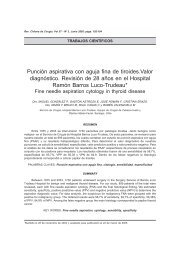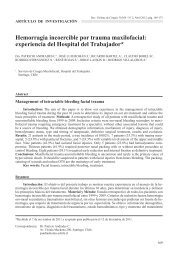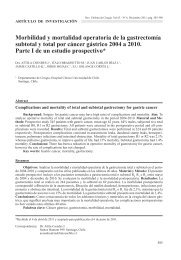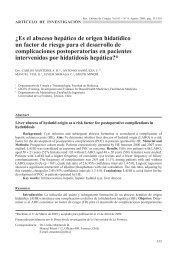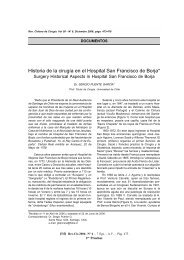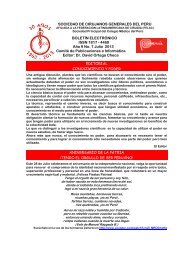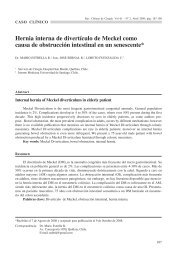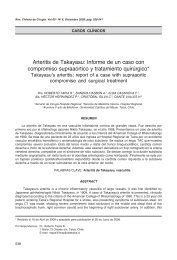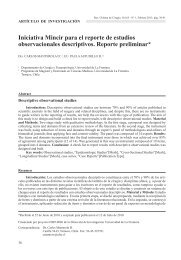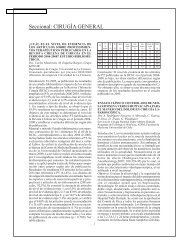Diseño de una escala para la evaluación de calidad ... - SciELO
Diseño de una escala para la evaluación de calidad ... - SciELO
Diseño de una escala para la evaluación de calidad ... - SciELO
- No tags were found...
Create successful ePaper yourself
Turn your PDF publications into a flip-book with our unique Google optimized e-Paper software.
ARTÍCULO DE INVESTIGACIÓNRev. Chilena <strong>de</strong> Cirugía. Vol 61 - Nº 1, Febrero 2009; pág. 59-72Diseño <strong>de</strong> <strong>una</strong> <strong>esca<strong>la</strong></strong> <strong>para</strong> <strong>la</strong> evaluación <strong>de</strong> <strong>calidad</strong>metodológica <strong>de</strong> estudios <strong>de</strong> pronóstico*Drs. HÉCTOR LOSADA M. 1,2 , CARLOS MANTEROLA D. 1,2 , VIVIANA PINEDA N. 1,2 ,MANUEL VIAL G. 1, 2 , ANTONIO SANHUEZA R. 1 GRUPO MINCIR1Departamento <strong>de</strong> Cirugía y Traumatología, Universidad <strong>de</strong> La Frontera.2Servicio <strong>de</strong> Cirugía, Hospital Hernán Henríquez Aravena. Temuco, Chile.AbstractDesign of a methodological quality scale for prognostic studiesBackground: One of the main c<strong>la</strong>ssification systems to <strong>de</strong>scribe the quality of scientific publicationsis the level of evi<strong>de</strong>nce. However, for our research team, the methodological quality is multidimensional.Aim: To <strong>de</strong>sign a scale to <strong>de</strong>termine the methodological quality of studies <strong>de</strong>aling with prognosis. Materia<strong>la</strong>nd Method: On a first stage, five professionals with experience in research were interviewed about theitems that, in their opinion, must be consi<strong>de</strong>red to assess the methodological quality of a manuscript. On asecond stage, 121 prognostic studies were critically reviewed by four professionals with research experienceIn addition, the number of publications of each author was <strong>de</strong>termined and the evi<strong>de</strong>nce level of eacharticle was <strong>de</strong>scribed according to the Oxford Centre for Evi<strong>de</strong>nce-based Medicine. A subsequent factoria<strong>la</strong>nalysis was performed and the fields and items of the scale were generated. Results: Sixty six percent ofreviewed articles had a cohort <strong>de</strong>sign (prospective or retrospective), 45% were located at an evi<strong>de</strong>nce level1b and 39% are at an evi<strong>de</strong>nce level of 4. After reviewing the articles, a factorial analysis was performedchoosing an orthogonal matrix. A scale (MinCir Pr) was generated with a total of 25 items, 6 fields and aCronbach coefficient alpha of 0.89. Conclusions: A scale to evaluate the methodological quality of prognosisstudies (MinCir Pr) was <strong>de</strong>signed, fulfilling rigorous methodological steps and the criterion ofmultidimensionality for methodological quality.Key words: Prognosis articles, scale <strong>de</strong>sign, methodological quality.ResumenIntroducción: Uno <strong>de</strong> los principales sistemas <strong>para</strong> calificar <strong>la</strong> <strong>calidad</strong> <strong>de</strong> <strong>la</strong>s publicaciones científicasha sido los niveles <strong>de</strong> evi<strong>de</strong>ncia. Para nuestro equipo <strong>de</strong> investigación el constructo <strong>calidad</strong> metodológicaes un constructo multidimensional. Nuestro objetivo es diseñar <strong>una</strong> <strong>esca<strong>la</strong></strong> <strong>para</strong> <strong>de</strong>terminar <strong>la</strong> <strong>calidad</strong>metodológica <strong>de</strong> los estudios referentes a pronóstico. Material y Método: Diseño <strong>de</strong> generación <strong>de</strong> <strong>esca<strong>la</strong></strong>s.En <strong>la</strong> primera etapa <strong>la</strong>s fuentes <strong>de</strong> los ítems fueron entrevistas en profundidad a 5 profesionales conexperiencia en investigación y <strong>la</strong> revisión <strong>de</strong> <strong>la</strong> literatura <strong>de</strong> los diferentes artículos acerca <strong>de</strong> evaluación <strong>de</strong>*Recibido el 29 <strong>de</strong> Septiembre <strong>de</strong> 2007 y aceptado <strong>para</strong> publicación el 10 <strong>de</strong> Julio <strong>de</strong> 2008.Financiado por proyecto DIDUFRO N°120629.Correspon<strong>de</strong>ncia: Dr. Héctor Losada M.Casil<strong>la</strong> 54-D. Temuco, ChileE-mail: hlosada@ufro.cl59
DISEÑO DE UNA ESCALA PARA LA EVALUACIÓN DE CALIDAD METODOLÓGICA...nica <strong>de</strong> reducción <strong>de</strong> dimensionalidad <strong>de</strong> los datos;su propósito último es buscar el número mínimo <strong>de</strong>dimensiones capaces <strong>de</strong> explicar el máximo <strong>de</strong> informacióncontenida en los datos. En éste etapa seescogen los dominios <strong>de</strong> <strong>la</strong> <strong>esca<strong>la</strong></strong> y se realiza e<strong>la</strong>nálisis <strong>de</strong> confiabilidad (alfa <strong>de</strong> Cronbach).Pob<strong>la</strong>ción: En <strong>la</strong> primera etapa <strong>de</strong> <strong>la</strong> <strong>esca<strong>la</strong></strong> <strong>la</strong>sfuentes <strong>de</strong> los ítems fueron entrevistas en profundidada 5 profesionales con experiencia en investigacióny <strong>la</strong> revisión <strong>de</strong> <strong>la</strong> literatura <strong>de</strong> los diferentesartículos acerca <strong>de</strong> evaluación <strong>de</strong> <strong>calidad</strong>metodológica 1-37 .En <strong>la</strong> segunda etapa <strong>la</strong> pob<strong>la</strong>ción fueron 121 estudios<strong>de</strong> pronóstico que fueron revisados por 4profesionales con experiencia en investigación, diferentesa los participantes en <strong>la</strong> primera etapa. A<strong>de</strong>másse analizó el número <strong>de</strong> publicaciones <strong>de</strong>l autory se calificó el nivel <strong>de</strong> evi<strong>de</strong>ncia <strong>de</strong> cada artículosegún el centro <strong>de</strong> evi<strong>de</strong>ncia <strong>de</strong> Oxford 1 .Tamaño <strong>de</strong> <strong>la</strong> muestra: Para el tamaño <strong>de</strong> muestraen los estudios <strong>de</strong> generación <strong>de</strong> <strong>esca<strong>la</strong></strong>s existenvarias recomendaciones. Una <strong>de</strong> estas hacemención a un intervalo <strong>de</strong> 5 a 10 mediciones porcada ítem <strong>de</strong> <strong>la</strong> <strong>esca<strong>la</strong></strong> 38 .El proceso matemático <strong>de</strong>l análisis factorial y <strong>la</strong>rotación <strong>de</strong> matrices requiere un mínimo <strong>de</strong> 120 mediciones.Es por esto que elegimos este número <strong>de</strong>artículos 39 .Selección <strong>de</strong> artículos: Los criterios <strong>de</strong> inclusión<strong>para</strong> los diferentes artículos fueron:• Estudios registrados en <strong>la</strong> base <strong>de</strong> datosMedline, bajo el término libre "prognosis study".• No habrá restricción en el año, ni idioma <strong>de</strong> publicación.De los artículos inicialmente seleccionados serevisará el resumen y se excluirán los artículos nore<strong>la</strong>cionados con pronóstico. Posteriormente, sebuscarán los artículos en texto completo <strong>para</strong> surevisión.Selección <strong>de</strong> investigadores: Los criterios <strong>de</strong> inclusión<strong>para</strong> los investigadores participantes fueron:• Certificación <strong>de</strong> epi<strong>de</strong>miólogo clínico o bioestadístico.• Pertenecer a <strong>una</strong> unidad o centro <strong>de</strong> epi<strong>de</strong>miologíaclínica.• Aceptación <strong>de</strong> participación en el protocolo.P<strong>la</strong>n <strong>de</strong> análisis: Se utilizó metodología <strong>de</strong> investigacióncualitativa en <strong>la</strong> primera etapa <strong>para</strong> e<strong>la</strong>nálisis <strong>de</strong> <strong>la</strong>s entrevistas en profundidad. Este serealizó con el programa At<strong>la</strong>s-Ti®.Rev. Chilena <strong>de</strong> Cirugía. Vol 61, Nº 1, Febrero 2009; pág 59-72Se utilizó estadística <strong>de</strong>scriptiva, con cálculo <strong>de</strong>medidas <strong>de</strong> ten<strong>de</strong>ncia central, dispersión y ten<strong>de</strong>nciaextrema; análisis divariado utilizando χ 2 <strong>de</strong>Pearson o test exacto <strong>de</strong> Fischer <strong>para</strong> variables categóricasy t-test, ANOVA y Kruskal Wallis <strong>para</strong>variables continuas. Los datos fueron analizadosutilizando el programa Stata® 8.0.Aspectos éticos y <strong>de</strong> financiamiento: Este protocolofue financiado por el proyecto DIUFRO No120629 <strong>de</strong> <strong>la</strong> Dirección <strong>de</strong> Investigación y Desarrollo<strong>de</strong> <strong>la</strong> Universidad <strong>de</strong> La Frontera.ResultadosLa primera etapa se enfocó a <strong>la</strong> selección <strong>de</strong> posiblesítems <strong>de</strong> <strong>la</strong> <strong>esca<strong>la</strong></strong>. Las fuentes <strong>de</strong> ítems fueron<strong>la</strong>s entrevistas en profundidad a 5 profesionalescon experiencia en investigación y <strong>la</strong> revisión<strong>de</strong> <strong>la</strong> literatura <strong>de</strong> los diferentes artículos acerca <strong>de</strong>evaluación <strong>de</strong> <strong>calidad</strong> metodológica <strong>de</strong> los estudios<strong>de</strong> pronóstico.Después <strong>de</strong> obtener los ítems <strong>de</strong> éstas 2 fuentes(metodología cualitativa y <strong>la</strong> revisión <strong>de</strong> <strong>la</strong> literatura)se realizó <strong>una</strong> reunión <strong>de</strong> consenso <strong>de</strong>l equipo<strong>de</strong> investigación <strong>para</strong> realizar un análisis <strong>de</strong> los diferentesítems encontrados; tratando <strong>de</strong> excluiraquellos que evaluaran los mismos aspectos yoptimizando <strong>la</strong> traducción al castel<strong>la</strong>no (Tab<strong>la</strong> 1).Posteriormente, se procedió a buscar los artículosen texto completo, <strong>para</strong> lo cual se tuvo <strong>la</strong> co<strong>la</strong>boración<strong>de</strong> <strong>la</strong> Universidad <strong>de</strong> Emory (E.U.).Se contó <strong>para</strong> <strong>la</strong> lectura completa con 130 artículos<strong>de</strong> los cuales se excluyeron 9 40-170 . Las causas<strong>de</strong> exclusión fueron:• Tres (3) artículos eran ensayos clínicos aleatoriosque evaluaban terapia.• Tres (3) eran revisiones sistemáticas <strong>de</strong> artículos<strong>de</strong> terapia.• Dos (2) eran estudios <strong>de</strong> metodología cualitativaque no hacían evaluación <strong>de</strong> pronóstico en ninguno<strong>de</strong> sus aspectos.• 1 (un) estudio era <strong>una</strong> prueba diagnóstica.En resumen, en esta primera etapa se analizaron121 artículos re<strong>la</strong>cionados con pronóstico, sin importarel diseño <strong>de</strong> investigación.Los artículos analizados tienen <strong>la</strong>s siguientes características:• 56 artículos (46%) no tienen hipótesis.• 6 artículos (5%) no tienen objetivos.• 83 artículos (68%) no mencionan el diseño <strong>de</strong>investigación utilizado.• 118 artículos (97%) no poseen cálculo <strong>de</strong>l tamaño<strong>de</strong> <strong>la</strong> muestra.61
DISEÑO DE UNA ESCALA PARA LA EVALUACIÓN DE CALIDAD METODOLÓGICA...evi<strong>de</strong>ncia 2, y 4 cuyo promedio <strong>de</strong> publicacionesfue 27,86 ± 33,26; sin embargo, esta diferencia noes estadísticamente significativa (p = 0,0752).Se encontró asociación entre el diseño empleadoen los estudios y <strong>la</strong> calificación <strong>de</strong> los niveles<strong>de</strong> evi<strong>de</strong>ncia (p = 000); con un coeficiente <strong>de</strong> corre<strong>la</strong>ción<strong>de</strong> 0,6607.Posteriormente, se realizó el análisis factorialdon<strong>de</strong> se escogió <strong>una</strong> matriz ortogonal <strong>para</strong> <strong>la</strong> rotación<strong>de</strong> los factores. Con base en éste análisis seextrajo el número mínimo <strong>de</strong> dimensiones capaces<strong>de</strong> explicar el máximo <strong>de</strong> información contenida enlos datos.Así tenemos los siguientes dominios e ítems:Dominio 1• Se <strong>de</strong>fine <strong>la</strong> variable <strong>de</strong> <strong>de</strong>sen<strong>la</strong>ce.• El método <strong>para</strong> medir <strong>la</strong> variable <strong>de</strong> <strong>de</strong>sen<strong>la</strong>ce esválido y confiable.• Se <strong>de</strong>fine <strong>la</strong>s unida<strong>de</strong>s <strong>de</strong> medida <strong>de</strong> <strong>la</strong> variable<strong>de</strong> <strong>de</strong>sen<strong>la</strong>ce.• Una a<strong>de</strong>cuada proporción <strong>de</strong> <strong>la</strong> muestra tienedatos completos <strong>de</strong> <strong>la</strong> variable <strong>de</strong> <strong>de</strong>sen<strong>la</strong>ce.• El método y <strong>la</strong>s unida<strong>de</strong>s <strong>de</strong> medición <strong>de</strong> <strong>la</strong>/<strong>la</strong>svariables <strong>de</strong> <strong>de</strong>sen<strong>la</strong>ce son los mismos <strong>para</strong> todoslos pacientes.Dominio 2• Se <strong>de</strong>fine <strong>la</strong> variable <strong>de</strong> exposición.• El método <strong>para</strong> medir <strong>la</strong> variable <strong>de</strong> exposiciónes válido y confiable.• Se <strong>de</strong>fine <strong>la</strong>s unida<strong>de</strong>s <strong>de</strong> medida <strong>de</strong> <strong>la</strong> variable<strong>de</strong> exposición.• Una a<strong>de</strong>cuada proporción <strong>de</strong> <strong>la</strong> muestra tienedatos completos <strong>de</strong> <strong>la</strong> variable <strong>de</strong> exposición.• El método y <strong>la</strong>s unida<strong>de</strong>s <strong>de</strong> medición <strong>de</strong> <strong>la</strong>/<strong>la</strong>svariables <strong>de</strong> exposición son los mismos <strong>para</strong> todoslos pacientes.Dominio 3• Se enuncia el porcentaje <strong>de</strong> pérdida <strong>de</strong> seguimiento.• Se <strong>de</strong>scriben <strong>la</strong>s características <strong>de</strong> los sujetosperdidos.• Se hicieron esfuerzos por recolectar <strong>la</strong> información<strong>de</strong> los sujetos perdidos.• Las causas <strong>de</strong> pérdida <strong>de</strong> seguimiento son <strong>de</strong>scritas.• Se analizaron <strong>la</strong>s diferencias entre <strong>la</strong>s características<strong>de</strong> los sujetos con pérdida <strong>de</strong> seguimientoy los que no.Dominio 4• Con los datos presentados es posible <strong>de</strong>terminar<strong>la</strong>s medidas <strong>de</strong> riesgo y asociación.• Se realizan mo<strong>de</strong>los <strong>de</strong> asociación o predictivos.Rev. Chilena <strong>de</strong> Cirugía. Vol 61, Nº 1, Febrero 2009; pág 59-72• El mo<strong>de</strong>lo elegido es a<strong>de</strong>cuado según el diseño<strong>de</strong>l estudio.• Las conclusiones <strong>de</strong>l estudio son coherentescon el objetivo y <strong>la</strong> metodología empleadas.Dominio 5• Se enuncia c<strong>la</strong>ramente el diseño <strong>de</strong>l estudio.• Consi<strong>de</strong>ra variables <strong>de</strong> confusión.• Se <strong>de</strong>finen a<strong>de</strong>cuadamente <strong>la</strong>s variables <strong>de</strong> confusión.• Los métodos <strong>para</strong> medir <strong>la</strong>s variables <strong>de</strong> confusiónson válidos y confiables.Dominio 6• Hay cálculo <strong>de</strong>l tamaño <strong>de</strong> <strong>la</strong> muestra.• Se justifica el tamaño <strong>de</strong> <strong>la</strong> muestra.El resultado <strong>de</strong>l cálculo <strong>de</strong>l alfa <strong>de</strong> Cronbach es:Dominio 1: alfa <strong>de</strong> Cronbach <strong>de</strong> 0,95.Dominio 2: alfa <strong>de</strong> Cronbach <strong>de</strong> 0,95.Dominio 3: alfa <strong>de</strong> Cronbach <strong>de</strong> 0,88.Dominio 4: alfa <strong>de</strong> Cronbach <strong>de</strong> 0,82.Dominio 5: alfa <strong>de</strong> Cronbach <strong>de</strong> 0,75.Dominio 6: alfa <strong>de</strong> Cronbach <strong>de</strong> 0,94.Con esto tenemos <strong>una</strong> <strong>esca<strong>la</strong></strong> (MinCir Pr) con untotal <strong>de</strong> 25 ítems, 6 dominios y un coeficiente <strong>de</strong>alfa <strong>de</strong> Cronbach <strong>de</strong> 0,89.Posteriormente, se <strong>de</strong>cidió utilizar <strong>una</strong> puntuacióndicotómica <strong>para</strong> <strong>la</strong> <strong>esca<strong>la</strong></strong>, utilizando 1 <strong>para</strong> elítem que no fue cumplido por el artículo y 5 <strong>para</strong> elítem que fue cumplido por el artículo.La <strong>esca<strong>la</strong></strong> (MinCir Pr) se <strong>de</strong>scribe en <strong>la</strong> Tab<strong>la</strong> 4.DiscusiónHay un creciente número <strong>de</strong> revisiones sistemáticasque están siendo publicadas en <strong>la</strong>s diferentesdisciplinas médicas. Esto tiene <strong>la</strong> ventaja <strong>de</strong> contarcon <strong>la</strong> información contenida en varios estudios<strong>de</strong>l mismo tema <strong>de</strong> investigación.Sin embargo varios artículos se han referido a <strong>la</strong>inconsistente <strong>calidad</strong> <strong>de</strong> alg<strong>una</strong>s revisiones sistemáticas171,172 y por tanto los errores <strong>de</strong> <strong>la</strong>s conclusionesextraídas <strong>de</strong> éstas; que en alg<strong>una</strong>s circunstanciasregu<strong>la</strong>n el quehacer médico.Dentro <strong>de</strong> los aspectos más importantes está <strong>la</strong>heterogeneidad y <strong>calidad</strong> <strong>de</strong> los estudios incluidos.Esta <strong>esca<strong>la</strong></strong> podría co<strong>la</strong>borar a resolver en parte ésteproblema al permitir evaluar numéricamente <strong>la</strong> <strong>calidad</strong><strong>de</strong> los diferentes estudios e incluso po<strong>de</strong>r sacarpromedios pon<strong>de</strong>rados por <strong>la</strong> <strong>calidad</strong> <strong>de</strong> cadatrabajo <strong>de</strong> <strong>la</strong>s diferentes variables, técnica utilizadapor el equipo <strong>de</strong> trabajo en alg<strong>una</strong>s <strong>de</strong> sus revisionessistemáticas.63
HÉCTOR LOSADA M. y cols.Tab<strong>la</strong> 4. Esca<strong>la</strong> MinCir <strong>para</strong> estudios <strong>de</strong> pronóstico (MinCir Pr)Esca<strong>la</strong> MINCIR pronóstico 1 5Dominio 1 (Variable <strong>de</strong> <strong>de</strong>sen<strong>la</strong>ce)Se <strong>de</strong>fine <strong>la</strong> variable <strong>de</strong> <strong>de</strong>sen<strong>la</strong>ceEl método <strong>para</strong> medir <strong>la</strong> variable <strong>de</strong> <strong>de</strong>sen<strong>la</strong>ce es válido y confiableSe <strong>de</strong>fine <strong>la</strong>s unida<strong>de</strong>s <strong>de</strong> medida <strong>de</strong> <strong>la</strong> variable <strong>de</strong> <strong>de</strong>sen<strong>la</strong>ceUna a<strong>de</strong>cuada proporción <strong>de</strong> <strong>la</strong> muestra tiene datos completos <strong>de</strong> <strong>la</strong>variable <strong>de</strong> <strong>de</strong>sen<strong>la</strong>ceEl método y <strong>la</strong>s unida<strong>de</strong>s <strong>de</strong> medición <strong>de</strong> <strong>la</strong>/<strong>la</strong>s variables <strong>de</strong> <strong>de</strong>sen<strong>la</strong>ceson los mismos <strong>para</strong> todos los pacientesDominio 2 (Variable <strong>de</strong> exposición)Se <strong>de</strong>fine <strong>la</strong> variable <strong>de</strong> exposiciónEl método <strong>para</strong> medir <strong>la</strong> variable <strong>de</strong> exposición es válido y confiableSe <strong>de</strong>fine <strong>la</strong>s unida<strong>de</strong>s <strong>de</strong> medida <strong>de</strong> <strong>la</strong> variable <strong>de</strong> exposiciónUna a<strong>de</strong>cuada proporción <strong>de</strong> <strong>la</strong> muestra tiene datos completos <strong>de</strong> <strong>la</strong>variable <strong>de</strong> exposiciónEl método y <strong>la</strong>s unida<strong>de</strong>s <strong>de</strong> medición <strong>de</strong> <strong>la</strong>/<strong>la</strong>s variables <strong>de</strong> exposiciónson los mismos <strong>para</strong> todos los pacientesDominio 3 (Seguimiento)Se enuncia el porcentaje <strong>de</strong> pérdida <strong>de</strong> seguimientoSe <strong>de</strong>scriben <strong>la</strong>s características <strong>de</strong> los sujetos perdidosSe hicieron esfuerzos por recolectar <strong>la</strong> información <strong>de</strong> los sujetosperdidosLas causas <strong>de</strong> pérdida <strong>de</strong> seguimiento son <strong>de</strong>scritasSe analizaron <strong>la</strong>s diferencias entre <strong>la</strong>s características <strong>de</strong> los sujetoscon pérdida <strong>de</strong> seguimiento y los que noDominio 4 (Análisis y conclusiones)Con los datos presentados es posible <strong>de</strong>terminar <strong>la</strong>s medidas <strong>de</strong> riesgoy asociaciónSe realizan mo<strong>de</strong>los <strong>de</strong> asociación o predictivosEl mo<strong>de</strong>lo elegido es a<strong>de</strong>cuado según el diseño <strong>de</strong>l estudioLas conclusiones <strong>de</strong>l estudio son coherentes con el objetivo y <strong>la</strong>metodología empleadasDominio 5 (Diseño y variables <strong>de</strong> confusión)Se enuncia c<strong>la</strong>ramente el diseño <strong>de</strong>l estudioConsi<strong>de</strong>ra variables <strong>de</strong> confusiónSe <strong>de</strong>finen a<strong>de</strong>cuadamente <strong>la</strong>s variables <strong>de</strong> confusiónLos métodos <strong>para</strong> medir <strong>la</strong>s variables <strong>de</strong> confusión son válidos yconfiablesDominio 6 (Tamaño <strong>de</strong> <strong>la</strong> muestra)Hay cálculo <strong>de</strong>l tamaño <strong>de</strong> <strong>la</strong> muestraSe justifica el tamaño <strong>de</strong> <strong>la</strong> muestraTotal64Rev. Chilena <strong>de</strong> Cirugía. Vol 61, Nº 1, Febrero 2009; pág 59-72
DISEÑO DE UNA ESCALA PARA LA EVALUACIÓN DE CALIDAD METODOLÓGICA...Con respecto a <strong>la</strong> metodología <strong>de</strong> <strong>la</strong> <strong>esca<strong>la</strong></strong>, éstacumplió varios pasos importantes en su proceso<strong>de</strong> diseño:• Extracción <strong>de</strong> posibles ítems con base en <strong>la</strong> experiencia<strong>de</strong> los autores y <strong>la</strong> literatura.• Revisión <strong>de</strong> los posibles ítems por un comité <strong>de</strong>expertos tratando <strong>de</strong> excluir aquellos que evaluaranlos mismos aspectos y optimizando <strong>la</strong> traducciónal castel<strong>la</strong>no.• Aplicación <strong>de</strong>l cuestionario inicial a 120 artículos<strong>de</strong> pronóstico.• Realización <strong>de</strong> análisis factorial <strong>para</strong> extraer ítemsy dominios.• Cálculo <strong>de</strong> <strong>la</strong> consistencia interna.En cuanto a <strong>la</strong>s <strong>de</strong>scripción <strong>de</strong> los estudios incluidosl<strong>la</strong>ma <strong>la</strong> atención alg<strong>una</strong>s cifras como el 68%<strong>de</strong> estudios que no mencionan el diseño <strong>de</strong> investigación,el 97% que no poseen cálculo <strong>de</strong>l tamaño<strong>de</strong> <strong>la</strong> muestra, el 20% que no tienen criterio <strong>de</strong> inclusióny el 52% sin criterio <strong>de</strong> exclusión. Esto podríainterpretarse como <strong>una</strong> baja <strong>calidad</strong> en <strong>la</strong> metodologíaempleada y l<strong>la</strong>ma <strong>la</strong> atención a los revisoresy editores <strong>de</strong> <strong>la</strong>s diferentes revistas científicasa mejorar sus estándares <strong>de</strong> publicación. A<strong>de</strong>másesto pue<strong>de</strong> reflejar <strong>una</strong> débil formación académicaen metodología <strong>de</strong> investigación, lo cual es <strong>una</strong>realidad en Latinoamérica y motiva a diversos centrosa diseñar programas <strong>para</strong> entrenamiento en ésteaspecto.Un aspecto adicional que se midió fue el número<strong>de</strong> publicaciones <strong>de</strong>l autor <strong>de</strong> cada artículo. En esteaspecto no encontramos asociación significativamenteestadística entre el promedio <strong>de</strong> artículos publicados<strong>de</strong> los autores con artículos nivel <strong>de</strong> evi<strong>de</strong>ncia1 y los autores con artículos nivel <strong>de</strong> evi<strong>de</strong>ncia2 y 4 (p = 0,0752). Esto pue<strong>de</strong> ser explicadopor algún sesgo en el número <strong>de</strong> publicaciones, yaque en muchos trabajos los autores son resi<strong>de</strong>nteso fellows y el staff o investigador principal no aparececomo autor. A<strong>de</strong>más cada vez hay un númerocreciente <strong>de</strong> publicaciones que no están in<strong>de</strong>xadasen MEDLINE, que son muy importantes <strong>para</strong> <strong>la</strong>sdiferentes socieda<strong>de</strong>s científicas don<strong>de</strong> publican investigadores<strong>de</strong> reconocida <strong>calidad</strong>.A<strong>de</strong>más, ésta nueva <strong>esca<strong>la</strong></strong> cumple el criterio teórico<strong>de</strong> multidimensionalidad <strong>de</strong> <strong>la</strong> <strong>calidad</strong> metodológica,aspecto muy importante <strong>para</strong> nuestro grupo<strong>de</strong> investigación. La siguiente etapa será <strong>la</strong> validación<strong>de</strong> <strong>la</strong> <strong>esca<strong>la</strong></strong>.ConclusiónSe ha diseñado <strong>una</strong> <strong>esca<strong>la</strong></strong> <strong>para</strong> <strong>la</strong> evaluación <strong>de</strong><strong>calidad</strong> metodológica <strong>de</strong> estudios <strong>de</strong> pronósticoRev. Chilena <strong>de</strong> Cirugía. Vol 61, Nº 1, Febrero 2009; pág 59-72(MinCir Pr) cumpliendo el criterio <strong>de</strong> multidimensionalidad<strong>de</strong> <strong>la</strong> <strong>calidad</strong> metodológica. Una vez validadapodría ser utilizada en revisiones sistemáticas.Referencias1. Oxford Centre for Evi<strong>de</strong>nce-based Medicine. Levelsof evi<strong>de</strong>nce. May 2001. Produced by Phillips B, BallC, Sackett D, et al., since November 1998. Disponibleen: http://163.1.96.10/docs/levels.html#levels. Consultadojunio 25 <strong>de</strong> 2005.2. Guyatt GH, Haynes RB, Jaeschke RZ, Cook DJ, GreenL, Naylor CD, et al. Users' Gui<strong>de</strong>s to the MedicalLiterature: XXV. Evi<strong>de</strong>nce-based medicine: principlesfor applying the Users' Gui<strong>de</strong>s to patient care.Evi<strong>de</strong>nce-Based Medicine Working Group. JAMA2000; 284: 1290-1296.3. Richardson WS, Wilson MC, Williams JW Jr, MoyerVA, Naylor CD. Users' gui<strong>de</strong>s to the medical literature:XXIV. How to use an article on the clinicalmanifestations of disease. Evi<strong>de</strong>nce-Based MedicineWorking Group. JAMA 2000; 284: 869-875.4. Giacomini MK Cook DJ. Users' gui<strong>de</strong>s to the medicalliterature: XXIII. Qualitative research in health careB. What are the results and how do they help me carefor my patients? Evi<strong>de</strong>nce-Based Medicine WorkingGroup. JAMA 2000; 284: 478-482.5. Giacomini MK, Cook DJ. Users' gui<strong>de</strong>s to the medicalliterature: XXIII. Qualitative research in health careA. Are the results of the study valid? Evi<strong>de</strong>nce-BasedMedicine Working Group. JAMA 2000; 284: 357-362.6. McGinn TG, Guyatt GH, Wyer PC, Naylor CD, StiellIG, Richardson WS. Users' gui<strong>de</strong>s to the medicalliterature: XXII: how to use articles about clinical<strong>de</strong>cision rules. Evi<strong>de</strong>nce-Based Medicine WorkingGroup. JAMA 2000; 284: 79-84.7. McAlister FA, Straus SE, Guyatt GH, Haynes RB. Users'gui<strong>de</strong>s to the medical literature: XX. Integratingresearch evi<strong>de</strong>nce with the care of the individualpatient. Evi<strong>de</strong>nce-Based Medicine Working Group.JAMA 2000; 283: 2829-2836.8. Hunt DL, Jaeschke R, McKibbon KA. Users' gui<strong>de</strong>s tothe medical literature: XXI. Using electronic healthinformation resources in evi<strong>de</strong>nce-based practice.Evi<strong>de</strong>nce-Based Medicine Working Group. JAMA2000; 283: 1875-1879.9. Bucher HC, Guyatt GH, Cook DJ, Holbrook A,McAlister FA. Users' gui<strong>de</strong>s to the medical literature:XIX. Applying clinical trial results. A. How to use anarticle measuring the effect of an intervention onsurrogate end points. Evi<strong>de</strong>nce-Based MedicineWorking Group. JAMA 1999; 282: 771-778.10. Barratt A, Irwig L, G<strong>la</strong>sziou P, Cumming RG, Raffle65
HÉCTOR LOSADA M. y cols.A, Hicks N et al. Users' gui<strong>de</strong>s to the medical literature:XVII. How to use gui<strong>de</strong>lines and recommendationsabout screening. Evi<strong>de</strong>nce-Based Medicine WorkingGroup. JAMA 1999; 281: 2029-2034.11. Guyatt GH, Sinc<strong>la</strong>ir J, Cook DJ, G<strong>la</strong>sziou P. Users'gui<strong>de</strong>s to the medical literature: XVI. How to use atreatment recommendation. Evi<strong>de</strong>nce-Based MedicineWorking Group and the Cochrane ApplicabilityMethods Working Group. JAMA 1999; 281: 1836-1843.12. Richardson WS, Wilson MC, Guyatt GH, Cook DJ,Nishikawa J. Users' gui<strong>de</strong>s to the medical literature:XV. How to use an article about disease probabilityfor differential diagnosis. Evi<strong>de</strong>nce-Based MedicineWorking Group. JAMA 1999; 281: 1214-1219.13. Dans AL, Dans LF, Guyatt GH, Richardson S. Users'gui<strong>de</strong>s to the medical literature: XIV. How to <strong>de</strong>ci<strong>de</strong>on the applicability of clinical trial results to yourpatient. Evi<strong>de</strong>nce-Based Medicine Working Group.JAMA 1998; 279: 545-549.14. O'Brien BJ, Hey<strong>la</strong>nd D, Richardson WS, Levine M,Drummond MF. Users' gui<strong>de</strong>s to the medical literature.XIII. How to use an article on economic analysis ofclinical practice. B. What are the results and will theyhelp me in caring for my patients? Evi<strong>de</strong>nce-BasedMedicine Working Group. JAMA 1997; 277: 1802-1806.15. Drummond MF, Richardson WS, O'Brien BJ, LevineM, Hey<strong>la</strong>nd D. Users' gui<strong>de</strong>s to the medical literature.XIII. How to use an article on economic analysis ofclinical practice. A. Are the results of the study valid?Evi<strong>de</strong>nce-Based Medicine Working Group. JAMA1997; 277: 1552-1557.16. Guyatt GH, Naylor CD, Juniper E, Hey<strong>la</strong>nd DK,Jaeschke R, Cook DJ. Users' gui<strong>de</strong>s to the medicalliterature. XII. How to use articles about health-re<strong>la</strong>tedquality of life. Evi<strong>de</strong>nce-Based Medicine WorkingGroup. JAMA 1997; 277: 1232-1237.17. Naylor CD, Guyatt GH. Users' gui<strong>de</strong>s to the medicalliterature. XI. How to use an article about a clinicalutilization review. Evi<strong>de</strong>nce-Based Medicine WorkingGroup. JAMA 1996; 275: 1435-1439.18. Naylor CD, Guyatt GH. Users' gui<strong>de</strong>s to the medicalliterature. X. How to use an article reporting variationsin the outcomes of health services. The Evi<strong>de</strong>nce-Based Medicine Working Group. JAMA 1996; 275:554-558.19. Guyatt GH, Sackett DL, Sinc<strong>la</strong>ir JC, Hayward R, CookDJ, Cook RJ. Users' gui<strong>de</strong>s to the medical literature.IX. A method for grading health care recommendations.Evi<strong>de</strong>nce-Based Medicine Working Group.JAMA 1995; 274: 1800-1804.20. Wilson MC, Hayward RS, Tunis SR, Bass EB, GuyattG. Users' gui<strong>de</strong>s to the Medical Literature. VIII. Howto use clinical practice gui<strong>de</strong>lines. B. what are therecommendations and will they help you in caring foryour patients? The Evi<strong>de</strong>nce-Based Medicine WorkingGroup. JAMA 1995; 274: 1630-1632.21. Hayward RS, Wilson MC, Tunis SR, Bass EB, GuyattG. Users' gui<strong>de</strong>s to the medical literature. VIII. How touse clinical practice gui<strong>de</strong>lines. A. Are the recommendationsvalid? The Evi<strong>de</strong>nce-Based Medicine WorkingGroup. JAMA 1995; 274: 570-574.22. Richardson WS, Detsky AS. Users' gui<strong>de</strong>s to the medicalliterature. VII. How to use a clinical <strong>de</strong>cision analysis.B. What are the results and will they help me incaring for my patients? Evi<strong>de</strong>nce Based MedicineWorking Group. JAMA 1995; 273: 1610-1613.23. Richardson WS, Detsky AS. Users' gui<strong>de</strong>s to the medicalliterature. VII. How to use a clinical <strong>de</strong>cision analysis.A. Are the results of the study valid? Evi<strong>de</strong>nce-BasedMedicine Working Group. JAMA 1995; 273: 1292-1295.24. Oxman AD, Cook DJ, Guyatt GH. Users' gui<strong>de</strong>s to themedical literature. VI. How to use an overview.Evi<strong>de</strong>nce-Based Medicine Working Group. JAMA1994; 272: 1367-1371.25. Laupacis A, Wells G, Richardson WS, Tugwell P. Users'gui<strong>de</strong>s to the medical literature. V. How to use anarticle about prognosis. Evi<strong>de</strong>nce-Based MedicineWorking Group. JAMA 1994; 272: 234-237.26. Levine M, Walter S, Lee H, Haines T, Holbrook A,Moyer V. Users' gui<strong>de</strong>s to the medical literature. IV.How to use an article about harm. Evi<strong>de</strong>nce-BasedMedicine Working Group. JAMA 1994; 271: 1615-1619.27. Jaeschke R, Guyatt GH, Sackett DL. Users' gui<strong>de</strong>s tothe medical literature. III. How to use an article abouta diagnostic test. B. What are the results and will theyhelp me in caring for my patients? The Evi<strong>de</strong>nce-Based Medicine Working Group. JAMA 1994; 271:703-707.28. Jaeschke R, Guyatt G, Sackett DL. Users' gui<strong>de</strong>s to themedical literature. III. How to use an article about adiagnostic test. A. Are the results of the study valid?Evi<strong>de</strong>nce-Based Medicine Working Group. JAMA1994; 271: 389-391.29. Guyatt GH, Sackett DL, Cook DJ. Users' gui<strong>de</strong>s to themedical literature. II. How to use an article abouttherapy or prevention. B. What were the results andwill they help me in caring for my patients? Evi<strong>de</strong>nce-Based Medicine Working Group. JAMA 1994; 271:59-63.30. Guyatt GH, Sackett DL, Cook DJ. Users' gui<strong>de</strong>s to themedical literature. II. How to use an article abouttherapy or prevention. A. Are the results of the studyvalid? Evi<strong>de</strong>nce-Based Medicine Working Group. JAMA1993; 270: 2598-2601.31. Oxman AD, Sackett DL, Guyatt GH. Users' gui<strong>de</strong>s tothe medical literature. I. How to get started. TheEvi<strong>de</strong>nce-Based Medicine Working Group. JAMA1993; 270: 2093-2095.66Rev. Chilena <strong>de</strong> Cirugía. Vol 61, Nº 1, Febrero 2009; pág 59-72
DISEÑO DE UNA ESCALA PARA LA EVALUACIÓN DE CALIDAD METODOLÓGICA...32. Begg C, Cho M, Eastwood S, Horton R, Moher D,Olkin I et al. Improving the quality of reporting ofrandomized controlled trials. The CONSORT statement.JAMA 1996; 276: 637-639.33. Bossuyt PM, Reitsma JB, Bruns DE, Gatsonis CA,G<strong>la</strong>szious PP, Irwig LM, et al. Towards complete andaccurate reporting of studies of diagnostic accuracy: TheSTARD Initiative. Ann Intern Med 2003; 138: 40-44.34. Mantero<strong>la</strong> C, Pineda V, Vial M, Losada H, Muñoz S.Revisión sistemática <strong>de</strong> <strong>la</strong> literatura. Propuesta metodológica<strong>para</strong> su realización. Rev Chil Cir 2003; 55:204-208.35. Bornhöft G, Maxion-Bergemann S, Wolf U, KienleGS, Michalsen A, Vollmar HC, et al. Checklist for thequalitative evaluation of clinical studies with particu<strong>la</strong>rfocus on external validity and mo<strong>de</strong>l validity. BMCMed Res Methodol 2006; 11: 56.36. Fineout-Overholt E, Melnyk BM. Evaluation of studiesof prognosis. Evid Based Nurs 2004; 7: 4-8.37. Hay<strong>de</strong>n JA, Côté P, Bombardier C. Evaluation of thequality of prognosis studies in systematic reviews. AnnIntern Med 2006; 144: 427-437.38. Streiner DL, Norman GR. Reliability. HealthMeasurement Scales. Ontario, Canada: OxfordUniversity Press, 1998: 104-126.39. Polit DF, Hungler BP. Procedimientos estadísticosavanzados. Investigacion cientifica. Ciudad <strong>de</strong> México:McGraw Hill Interamericana, 1997: 435-475.40. The Japanese Trial to Assess Optimal Systolic BloodPressure in El<strong>de</strong>rly Hypertensive Patients (JATOS):Protocol, Patient Characteristics, and Blood Pressureduring the First 12 Months. Hypertens Res 2005; 28:513-520.41. Abou-Khalil B, Schaich L. Long-term efficacy oflevetiracetam for partial seizures. Seizure 2005; 14:557-585.42. Akaraviputh T, Boonnuch W, Lohsiriwat V, MethasateA, Chinswangwatanakul V, Lert-akayamanee N, et al.Long-Term Results of Large Diameter Hepaticojejunostomyfor Treatment of Bile Duct InjuriesFollowing Cholecystectomy. J Med Assoc Thai 2006;89: 657-662.43. Al-Ruzzeh S, Ambler G, Asimakopoulos G, Omar R,Hasan R, Fabri B, et al. Off-Pump Coronary ArteryBypass (OPCAB) Surgery Reduces Risk-StratifiedMorbidity and Mortality: A United Kingdom Multi-Center Com<strong>para</strong>tive Analysis of Early ClinicalOutcome. Circu<strong>la</strong>tion 2003; 108: 1-8.44. Atzema C, Mower W, Hoffman J, Holmes J, KillianA, Wolfson A. Prevalence and Prognosis of TraumaticIntraventricu<strong>la</strong>r Hemorrhage in Patients with BluntHead Trauma. J Trauma 2006; 60:1010-1017.45. Atar E, Bachar G, Eitan M, Graif F, Neyman H,Belenky A. Peripheral cutting balloon in the managementof resistant benign ureteral and biliarystrictures: long-term results. Diagnostic and InterventionalRadiology 2007; 13: 39-41.46. Bal<strong>la</strong>rd J, McFar<strong>la</strong>nd C, Silver L, Holiday D, RobersonG. The Effect of 15 Weeks of Exercise on Ba<strong>la</strong>nce,Leg Strength, and Reduction in Falls in 40 WomenAged 65 to 89 Years. JAMWA 2004; 59: 255-261.47. Bartsch R, Wenzel C, Pluschnig U, Hussian D, SeveldaU, Altorjai G, et al. Prognostic value of monitoringtumour markers CA 15-3 and CEA during fulvestranttreatment. BMC Cancer 2006; 6: 1-7.48. Bastiaenen C, De Bie R, Wolters P, V<strong>la</strong>eyen J,Bastiaanssen J, K<strong>la</strong>bbers A, et al. Treatment ofpregnancy-re<strong>la</strong>ted pelvic girdle and/or low back painafter <strong>de</strong>livery <strong>de</strong>sign of a randomized clinical trial withina comprehensive prognostic cohort study. BMC PublicHealth 2004; 4: 1-12.49. Becattini C, Agnelli G, Prandoni P, Silingardi M, SalviR, Taliani M et al. A Prospective study on cardiovascu<strong>la</strong>revents after acute pulmonary embolism.European Heart Journal 2005; 26: 77-83.50. Beghi E, Tonini C. Surgery for epilepsy: Assessingevi<strong>de</strong>nce from observational studies. Epilepsy Research2006; 1-6.51. Bodí V, Faci<strong>la</strong> L, Sanchis J, Llácer A, Núñez J, MainarL, et al. Short-Term Prognosis of Patients Admittedfor Probable Acute Coronary Syndrome without ST-Segment Elevation. Role of New Myocardial DamageMarkers and Acute-Phase Reactants. Rev Esp Cardiol2002; 55: 823-830.52. Bohm M, Pronicka E, Karczmarewicz E, Pronicki M,Piekutowska-Abramczuk D, Sykut-Cegielska J et al.Retrospective, Multicentric Study of 180 Children withCytochrome c Oxidase Deficiency. Pediatr Res 2006;59: 21-26.53. Bottio T, Rizzoli G, Caprili L, Nesseris G, Thiene G,Gerosa G. Full-Sternotomy Off-Pump versus On-PumpCoronary Artery Bypass Procedures. Tex Heart Inst J2003; 30: 261-267.54. Bradford N, Shappell S, Chang S, Wells N, Farnham S,Smith J, et al. Tumour volume is an in<strong>de</strong>pen<strong>de</strong>ntpredictor of prostate-specific antigen recurrence inpatients un<strong>de</strong>rgoing radical prostatectomy for clinicallylocalized prostate cancer. Urological Oncology 2006;97: 1169-1172.55. Brouman B, Sadat M, Shafiel M. Impact of HepatitisC Virus Infection on Short-Term Outcomes in RenalTransp<strong>la</strong>ntation. Experimental and Clinical Transp<strong>la</strong>ntation2004; 2: 242-245.56. Brunner M, Olschewski M, Geibel A, Bo<strong>de</strong> C, Zehen<strong>de</strong>rM. Long-term survival after pacemaker imp<strong>la</strong>ntation.Prognosticimportance of gen<strong>de</strong>r and baselinepatient characteristics. European Heart Journal 2004;25: 88-95.57. Budoff M, Shaw L, Liu S, Weinstein S, Mosler T,Tseng P, et al. Long-Term Prognosis Associated WithCoronary Calcification. J Am Coll Cardiol 2007; 49:1860-1870.Rev. Chilena <strong>de</strong> Cirugía. Vol 61, Nº 1, Febrero 2009; pág 59-7267
HÉCTOR LOSADA M. y cols.58. Calverley P, Boonsawat W, Cseke Z, Zhong N,Peterson S, Olsson H. Maintenance therapy withbu<strong>de</strong>soni<strong>de</strong> and formoterol in chronic obstructivepulmonary disease. Eur Respir J 2003; 22: 912-919.59. Canavan C, Abrams K, Hawthorne B, Drossman D,Mayberry J. Long-term prognosis in Crohn's disease:factors that affect quality of life. Aliment PharmacolTher 2006; 23: 377-385.60. Cappelleti V, Celio L, Bajetta E, Allevi A, LongariniR, Miodini P, et al. Prospective evaluation of estrogenreceptor-β in predicting response to neoadjuvantantiestrogen therapy in el<strong>de</strong>rly breast cancer patients.Endocrine-Re<strong>la</strong>ted Cancer 2004; 11: 761-770.61. Catelin C, Tordjman S, Morin V, Oger E, Sizun J.Clinical, Physiologic, and Biologic Impact ofEnvironmental and Behavioral Interventions inneonates During a Routine Nursing Procedure. TheJournal of Pain 2006; 12: 791-797.62. Chang-Kwon O, Sawyer R, Pelletier S, Pruett T, SanfeyH. In<strong>de</strong>pen<strong>de</strong>nt Predictors for Primary Non-Functionafter Liver Transp<strong>la</strong>ntation. Yonsei Medical Journal2004; 45: 1155-1161.63. Cheung A, Levin N, Greene T, Agodoa L, Bailey J,Beck G et al. Effects of High-Flux Hemodialysis onClinical Outcomes: Results of the HEMO Study. J AmSoc Nephrol 2003; 14: 3251-3263.64. Cheung C, Tsoi T, Hon S, Au-Yeung M, Shiu K, LeeC, et al. Outcomes after first-ever stroke. Hong KongMed J 2007; 13: 95-99.65. Chow T, Kereiakes D, Bartone C, Booth T, SchlossE, Waller T, et al. Prognostic Utility of Microvolt T-Wave Alternant in Risk Stratification of Patients WithIschemic Cardiomyopathy. J Am Coll Cardiol 2006;47: 1820-1827.66. Co<strong>la</strong>n S, McElhinney D, Crawford E, Keane J, Lock J.Validation and Re- Evaluation of a Discriminant Mo<strong>de</strong>lPredicting Anatomic Suitability for Biventricu<strong>la</strong>rRepair in Neonates With Aortic Stenosis. J Am CollCardiol 2006; 47: 1858-1865.67. De Waele J, Hoste E, Blot S, Hesse U, Pattyn P, DeHemptinne B, et al. Perioperative factors <strong>de</strong>termineoutcome after surgery for severe acute pancreatitis.Critical Care 2004; 8: 504-511.68. Dignam J, Wieand K, Johnson K, Fisher B, Xu L.Obesity, Tamoxifen Use, and Outcomes in WomenWith Estrogen Receptor-Positive Early-Stage BreastCancer. J Natl Cancer Inst 2003; 95: 1467-1476.69. Dome J, Cotton C, Perlman E, Breslow N, Ka<strong>la</strong>purakalJ, Ritchey M, et al. Treatment of Anap<strong>la</strong>stic HistologyWilms' Tumor: Results From The Fifth NationalWilms' Tumor Study. J Clin Oncol 2006; 24: 2352-2358.70. Dunkelgrun M, Hoeks S, Elhendy A, Van Domburg R,Bax J, Noordzij P, et al. Significance of hypotensiveresponse during dobutamine stress echocardiography.International Journal of Cardiology 2007; 20: 1-6.71. E<strong>la</strong>hi M, Hadjiniko<strong>la</strong>ou L, Galiñanes M. Inci<strong>de</strong>nce andClinical Consequences of Atrial Fibril<strong>la</strong>tion Within 1Year of First-Time Iso<strong>la</strong>ted Coronary Bypass Surgery.Circu<strong>la</strong>tion 2003; 108: 207-212.72. Empana J, Ducimetiére P, Arveiler D, Ferriéres J,Evans A, Ruidavets J, et al. Are the Framingham andPROCAM coronary heart disease risk functionsapplicable to different European popu<strong>la</strong>tions?European Heart Journal 2003; 24: 1903-1911.73. Ewald N, Marzeion A, Bretzel R, Ulrich H, Hardt P.Endoscopic Sphincterotomy in patients with stenosisof ampul<strong>la</strong> of Vater: Three-year follow-up of exocrinepancreatic function and clinical symptoms. World JGastroenterol 2007; 13: 901-905.74. Fairburn C, Agras S, Walsh T, Wilson T, Stice E.Prediction of Outcome in Bulimia Nervosa by EarlyChange in Treatment. Am J Psychiatry 2004; 161:2322-2324.75. Fairman R, Nolte L, Sny<strong>de</strong>r S, Chuter T, Greenberg R.Factors predictive of early or <strong>la</strong>te aneurysm sac sizechange following endovascu<strong>la</strong>r repair. J Vasc Surg 2006;43: 649-656.76. Falvo L, Giacomelli Laura, D'Andrea V, Marzullo A,Guerriero G, De Antoni E. Prognostic Importance ofSclerosing Variant in Papil<strong>la</strong>ry Thyroid Carcinoma.The American Surgeon 2006; 72: 438-444.77. Farinati F, Marino D, De Giorgio M, Baldan A,Cantarini M, Cursaro C, et al. Diagnostic and PrognosticRole of Fetoprotein in Hepatocellu<strong>la</strong>r Carcinoma:Both or Neither? Am J Gastroenterol 2006; 101:524-532.78. Fergusson D, Bo<strong>de</strong>n J, Horwood J. Abortion AmongYoung Women And Subsequent Life Outcomes.Perspectives on Sexual and Reproductive Health 2007;39: 6-12.79. Ferrer J, Domínguez A, García M, Abreu P,Bethencourt M, Marrero F. Influencia <strong>de</strong> <strong>la</strong> diabetesmellitus en el tratamiento y el pronóstico <strong>de</strong>l síndromecoronario agudo sin elevación <strong>de</strong>l segmento ST.Rev Esp Cardiol 2006; 59: 383-386.80. Flori H, Glid<strong>de</strong>n D, Rutherford G, Matthay M. PediatricAcute Lung Injury Prospective Evaluation of RiskFactors Associated with Mortality. American Journalof Respiratory and Critical Care Medicine 2005; 171:995-1001.81. Franco E, Palumbo L, Crobu F, Anselmino M, Frea S,Matullo G, et al. Renin-angiotensin-aldosterone systempolymorphisms: a role or a hole in ocurrence andlong-term prognosis of acute myocardial infarction atyoung age. BMC Medical Genetics 2007; 8.82. Franneby U, Sandblom G, Nordin P, Nyrén O,Gunnarsson U. Risk Factors for Long-term Pain AfterHernia Surgery. Ann Surg 2006; 244: 212-219.83. Freixinet J, Juliá-Serdá G, Rodríguez P, Santana N,Rodríguez F, Fiuza M, et al. Hospital volume: operativemorbidity, mortality and survival in thoracotomy for68Rev. Chilena <strong>de</strong> Cirugía. Vol 61, Nº 1, Febrero 2009; pág 59-72
HÉCTOR LOSADA M. y cols.111.Langagergaard V, Gislum M, Skriver MV, Norgard B,Lash TL, Rothman KJ et al. Birth outcome in womenwith breast cancer. British Journal of Cancer 2006;94: 142-146.112.Le G, O'Malley C, G<strong>la</strong>ser S, Lynch C, Stanford J,Keegan T, et al. Breast imp<strong>la</strong>nts followingmastectomy in women with early-stage breast cancer:prevalence and impact on survival. Breast CancerResearch 2005; 7: 184-193.113.Leong K, Goh P, Chang B, Lingamanaicker J. HeartFailure cohort in Singapore with <strong>de</strong>fined criteria: clinicalcharacteristics and prognosis in a multi-ethnic hospital-basedcohort in Singapore. Singapore Med J 2007;48: 408-414.114.Letho M, Snapinn S, Dickstein K, Swedberg K,Nieminen M. Prognostic risk of atrial fibril<strong>la</strong>tion inacute myocardial infarction complicated by leftventricu<strong>la</strong>r dysfunction: the OPTIMAAL experience.European Heart Journal 2005; 26: 350-356.115.Ljung T, Karlén P, Schmidt D, Hellstrom P, LapidusA, Janczewska I, et al. Infliximab in inf<strong>la</strong>mmatorybowel disease:clinical outcome in a popu<strong>la</strong>tion basedcohort from Stockholm Country. Gut 2004; 53: 849-853.116.Losada H, Mantero<strong>la</strong> C, Pineda V, Vial M. Asociaciónentre recuento bacteriano en <strong>la</strong> bilis y variables fisiológicascon <strong>la</strong>s complicaciones postquirúrgicas en pacientescon co<strong>la</strong>ngitis aguda en un hospital <strong>de</strong>l sur <strong>de</strong>Chile. En prensa Rev Chil Cir.117.Marín M, Hollier L, Ellozy S, Spielvogel D, Mitty H,Griepp R, et al. Endovascu<strong>la</strong>r Stent Graft Repair ofAbdominal and Thoracic Aortic Aneurysms. Ann Surg2003; 238: 586-595.118.McCulloch P, Ward J, Tekkis P. Mortality andmorbidity in gastro-oesophageal cancer surgery: initialresults of ASCOT multicentre prospective cohortstudy. BMJ 2003; 327: 1192-1197.119.McCulloch P, Ward J, Tekkis P. Mortality andmorbidity in gastro-oesophageal cancer surgery: initialresults of ASCOT multicentre prospective cohortstudy. BMJ 2006; 327: 1-6.120.McDuffie C, Amirghahari N, Caldito G, Lian T,Thompson L, Nathan C. Predictive Factors for PosteriorTriangle Metastasis in HNSCC. Laryngoscope2005; 115: 2114-2117.121.Meijer R, Van Limbeek J, Peusens G, Rulkens M,Dankoor K, Vermeulen M, et al. The Stroke unitDischarge Gui<strong>de</strong>line, a prognostic Framework for thedischarge outcome from the hospital stroke unit. Aprospective cohort study. Clinical Rehabilitation 2005;19: 770-778.122.Meisinger C, Loewel H, Mraz W, Koenig, W.Prognostic value of apolipoprotein B and A-I in theprediction of myocardial infarction in middle-aged menand women: results from the MONICA/KORAAugsburg cohort study. European Heart Journal 2005;26: 271-278.123.Melloni G, Doglioni C, Bandiera A, Carretta A, CiriacoP, Arrigoni G, et al. Prognostic Factors and Analysisof Microsatellite Instability in Resected PulmonaryMetastases From Colorectal Carcinoma. Ann ThoracSurg 2006; 81: 2008-2013.124.Menén<strong>de</strong>z R, Nauffal D, Crema<strong>de</strong>s M. Prognosticfactors in restoration of pulmonary flow aftersubmassive pulmonary embolism: a multiple regressionanalysis. Eur Respir J 1998; 11: 560-564.125.Meyerhardt J, Cata<strong>la</strong>no P, Schrag D, Ayanian J, HallerD, Mayer R, et al. Association of Hospital ProcedureVolume and Outcomes in Patients with Colon Cancerat High Risk for Recurrence. Ann Intern Med 2003;139: 649-657.126.Miquel J, Abad R, Souto J, Fabra R, Vi<strong>la</strong> M, BargallóD, et al. EUS-gui<strong>de</strong>d mucosectomy for gastrointestinalcancer. Revista Españo<strong>la</strong> <strong>de</strong> Enfermeda<strong>de</strong>s Digestivas2006; 98: 591-596.127.Morris M, Lacopetta B, P<strong>la</strong>tell C. Comparing Survivaloutcomes for patients with colorectal cancer treatedin public and private hospitals. MJA 2006; 186: 296-300.128.Morris M, Lacopetta B, P<strong>la</strong>tell C. Comparing survivaloutcomes for patients with colorectal cancer treatedin public and private hospitals. MJA 2007; 186: 296-300.129.Motohashi M. Profile of bi<strong>la</strong>teral anterior cruciateligament injuries: A retrospective follow-up study.Journal of Orthopaedic Surgery 2004; 12: 210-215.130. Mukamal K, Maclure M, Muller J, Sherwood J,Mittleman M. Caffeinated coffee consumption andmortality after acute myocardial infarction. Am HeartJ 2004; 147:999-1004.131.Muller S, Prol<strong>la</strong> J, Maguilnik I, Breyer H. PredictiveFactors of Oxygen Desaturation of Patients SubmittedTo Endoscopic Retrogra<strong>de</strong> Cho<strong>la</strong>giopancreatographyUn<strong>de</strong>r Conscious Sedation. Arq Gastroenterol 2004;41: 162-166.132.Muneuchi G, Miyabe K, Hoshikawa H, Hata Y, SuzukiS, Igawa H, et al. Postoperative complications andlong-term prognosis of microsurgical reconstructionafter total maxillectomy. Microsurgery 2006; 26: 171-176.133.Panda S, Goyal V, Behari M, Singh S, Srivastava T.Myasthenic crisis: A retrospective study. NeurologyIndia 2004; 52: 453-456.134.Penido J, Santos J, Parizzoto V, Moreira E, Bahia L,Affonso M, et al. Clinical course of 735 children andadolescents with primary vesicoureteral reflux. IPNA2006.135.Pérez K, Titus-Ernstoff L, Hatch E, Troisi R,Wactawski-Wen<strong>de</strong> J, Palmer J, et al. Reproductiveoutcomes in men with prenatal exposure todiethylstilbestrol. Fertil Steril 2005; 84: 1649-1656.136.Pérez <strong>de</strong> Luque D, López P, Montero J, Fraga E,70Rev. Chilena <strong>de</strong> Cirugía. Vol 61, Nº 1, Febrero 2009; pág 59-72
DISEÑO DE UNA ESCALA PARA LA EVALUACIÓN DE CALIDAD METODOLÓGICA...Barrera, P,Costán G et al. Survival of patients receivinga liver transp<strong>la</strong>nt for hepatocellu<strong>la</strong>r carcinoma, andrisk of tumor recurrence. Revista Españo<strong>la</strong> <strong>de</strong> Enfermeda<strong>de</strong>sDigestivas 2006; 98: 899-906.137.Pineda J, Marín F, Roldán V, Valencia J, Marco P,Sogorb F. Premature myocardial infarction: Clinicalprofile and angiographic findings. International Journalof Cardiology 2007; 20: 1-3.138.Piombo A, Gagliardi J, Guetta J, Fuselli J, Salzberg S,Fairman E, et al. A new scoring system to stratify inunstable angina. BMC Cardiovascu<strong>la</strong>r Disor<strong>de</strong>rs 2003;3:2-9.139. Rajah J, Riera-Fanego J, Keeton J, Ramjee A, BhanaR, Lasersohn L, et al. Do steroids prevent reintubationin children with <strong>la</strong>ryngotracheobronchitis? Crit Care2000; 4: 314-318.140.Rech T, Rios S, Nagel F, Salles J, Scalco R. Serumneuron-specific en<strong>la</strong>ce as early predictor of outcomeafter in-hospital cardiac arrest: a cohort study. CriticalCare 2006; 10:1-6.141.Rosted P, Bundgaard M. Can Acupuncture Reduce theInduction Time of a Local Anaesthetic? - A PilotStudy. Acupuncture in Medicine 2003; 21: 92-99.142.Sacco S, Marini C, Totaro R, Russo T, Cerone D,Carolei A. A popu<strong>la</strong>tion-based study of the inci<strong>de</strong>nceand prognosis of <strong>la</strong>c<strong>una</strong>r stroke. Neurology 2006; 66:1335-1338.143.Sanchís J, Bertomeu V, Bodí V, Núñez J, Lauwers C,Ruiz-Nodar J, et al. Estrategia invasiva en pacientescon diabetes avanzada y síndrome coronario agudo sinelevación <strong>de</strong>l segmento ST. Hal<strong>la</strong>zgos angiográficos yevolución clínica. Resultados <strong>de</strong>l estudio PREDICAR.Rev Esp Cardiol 2006; 59: 321-328.144.Shishehbor M, Topol E, Mukherjee D, Hu T, CohenD, Stone G et al. Outcome of Multivessel CoronaryIntervention in the Contemporary PercutaneousRevascu<strong>la</strong>rization Era. Am J Cardiol 2006; 97: 1585-1590.145.Singhi P, Bansal A, Geeta P, Singhi S. Predictors ofLong Term Neurological Outcome in Bacterial Meningitis.Indian Journal of Pediatrics 2007; 74: 369-374.146.Sogaard O, Lemoh C, Spelman D, Freundlich M,Schonhey<strong>de</strong>r H, Jensen R, et al. A binational cohortstudy of venti<strong>la</strong>tor-associated pneumonia in Denmarkand Australia. Scandinavian Journal of InfectiousDiseases 2006; 38: 256-264.147.Soto G, Jones P, Weintraub W, Krumholz H, SpertusJ. Prognostic Value of Health Status in Patients WithHeart Failure After Acute Myocardial Infarction.Circu<strong>la</strong>tion 2004; 110: 546-551.148.Staresinic A, Sorkness C, Goodman B, Pigarelli D.Comparison of Outcomes Using 2 Delivery Mo<strong>de</strong>ls ofAnticoagu<strong>la</strong>tion Care. Arch Intern Med. 2006; 166:997-1002.149.Stein P, Henry J, Relyea B. Untreated patients withpulmonary embolism. Outcome, clinical, and<strong>la</strong>boratory assessment. CHEST 1995; 107: 931-935.150.Strate T, Taherpour Z, Bloechle C, Mann O, Bruhn J,Schnei<strong>de</strong>r C, et al. Long-term Follow-up of aRandomized Trial Comparing the Beger and FreyProcedures for Patients Suffering From ChronicPancreatitis. Ann Surg 2005; 241: 591-598.151.Tadokoro K, Miyamoto H, Sumi M, Shimomura. ThePrognostic of Conservative Treatments for LumbarSpinal Stenosis. Spine 2005; 30: 2458-2463.152.Texereau J, Jamal D, Choukroun G, Burgel P, Diehl J,Rabbat A, et al. Determinants of mortality for adultswith cystic fibrosis admitted in Intensive Care Unit: amulticenter study. Respiratory Research 2006; 7: 14.153.Toh C, Wong E, Lim W, Leong S, Fong K, Wee J, etal. The Impact of Smoking Status on the Behaviorand Survival Outcome of Patients With AdvancedNon-small Cell Lung Cancer: A RetrospectiveAnalysis. CHEST 2004; 126: 1750-1756.154.Tuttolomondo A, Pedone C, Pinto A, Di RaimondoD, Fernán<strong>de</strong>z P, Di Sciacca R, et al. Predictors ofoutcome in acute ischemic cerebrovascu<strong>la</strong>r syndromes:The GIFA study. International Journal of Cardiology2006; 20: 1-6.155.Ural E, Yuksel H, Pehlivanoglu S, Bakay C, Olga R.Short and Long Term Survival of Surgical Treatmentof Left Ventricu<strong>la</strong>r Aneurysms. Jpn Heart J 2002; 43:379-387.156.Van Balken M, Vergunst H, Bemelmans B. PrognosticFactors for Successful Percutaneous Tibial NerveStimu<strong>la</strong>tion. European Urology 2006; 49: 360-365.157.Van <strong>de</strong> Beek D, De Gans J, Spanjaard L, Weisfelt M,Reitsma J, Vermeulen M. Clinical Features andPrognostic Factors in Adults with Bacterial Meningitis.N Engl J Med 2004; 351: 1849-1859.158.Van Walraven C, Jennings A, Oake N, Fergusson D,Forster A. Effect of Study Setting on Anticoagu<strong>la</strong>tionControl. CHEST 2006; 129: 1155-1166.159. Vukmir R, Katz L. Sodium bicarbonate improvesoutcome in prolonged prehospital cardiac arrest.American Journal of Emergency Medicine 2006; 24:156-161.160.Wapnir I, An<strong>de</strong>rson S, Mamo<strong>una</strong>s E, Geyer Jr C, JeongJ, Tan-Chiu, et al. Prognostic After Ipsi<strong>la</strong>teral BreastTumor Recurrence and Locoregional Recurrences inFive National Surgical Adjuvant Breast and BowelProject No<strong>de</strong>-Positive Adjuvant Breast Cancer Trials.J Clin Oncol 2006; 24: 2028-2037.161.Ward J, Cherry J, Chang S, Partridge S, Lee H, TreanorJ, et al. Efficacy of an Acellu<strong>la</strong>r Pertussis Vaccineamong Adolescents and Adults. N Engl J Med 2005;353: 1555-1563.162.Webster S, Lohse C, Thompson H, Dong H, Frigo<strong>la</strong>X, Dicks D, et al. Mononuclear Cell Infiltration inClear-Cell Renal Cell Carcinoma In<strong>de</strong>pen<strong>de</strong>ntlyPredicts Patient Survival. Cancer 2006; 107: 46-53.Rev. Chilena <strong>de</strong> Cirugía. Vol 61, Nº 1, Febrero 2009; pág 59-7271
HÉCTOR LOSADA M. y cols.163.Wilson I, Duszynski K, Mant A. A 5-year follow-upof general practice patients experiencing <strong>de</strong>pression.Family Practice 2003; 20: 685-689.164.Yoshida M, Ohtsu A, Boku N, Miyata Y, Shirao K,Shimada Y, et al. Long-term Survival and PrognosticFactors in Patients with Metastatic Gastric CancersTreated with Chemotherapy in the Japan ClinicalOncology Group (JCOG) Study. Jpn J Clin Oncol 2004;34: 654-659.165.Zeymer U, Vogt A, Zahn R, Weber M, Tebbe U,Gottwik M, et al. Predictors of in-hospital mortalityin 1333 patients with acute myocardial infarctioncomplicated by cardiogenic shock treated with primarypercutaneous coronary intervention (PCI). EuropeanHeart Journal 2004; 25: 322-328.166.Zheng L, Jia H, Wu D, Shang H, Zhong X, Wang Q,et al. Experience of Congenital Choledochal Cyst inAdults: Treatment, Surgical Procedures and ClinicalOutcome in the Second Affiliated Hospital of HarbinMedical University. J Korean Med Sci 2004; 19: 842-847.167.Zhou L, Rui J, Wang S, Chen S, Qu Q, Chi T, et al.Clinicopathological features, post-surgical survival andprognostic indicators of el<strong>de</strong>rly patients withhepatocellu<strong>la</strong>r carcinoma. EJSO 2006; 20: 1-6.168.Zhou P, Chen M, McLeod D, Carroll P, Moul J,D'Amico A. Predictors of Prostate Cancer-SpecificMortality After Radical Prostatectomy or RadiationTherapy. J Clin Oncol 2005; 23: 6992-6998.169.Dixon E, Hameed M, Suther<strong>la</strong>nd F, Cook D, Doig C.Evaluating meta-analyses in the general surgicalliterature. A critical appraisal. Ann Surg 2005; 241:450-459.170.Moher D, Tetz<strong>la</strong>ff J, Tricco A, Sampson M, AltmanD. Epi<strong>de</strong>miology and reporting characteristics ofsystematic reviews. PLoS Medicine 2007; 4: 447-455.Disponible en: http:www.medicine.plosjournals.org.Consultado octubre <strong>de</strong> 2007.72Rev. Chilena <strong>de</strong> Cirugía. Vol 61, Nº 1, Febrero 2009; pág 59-72



